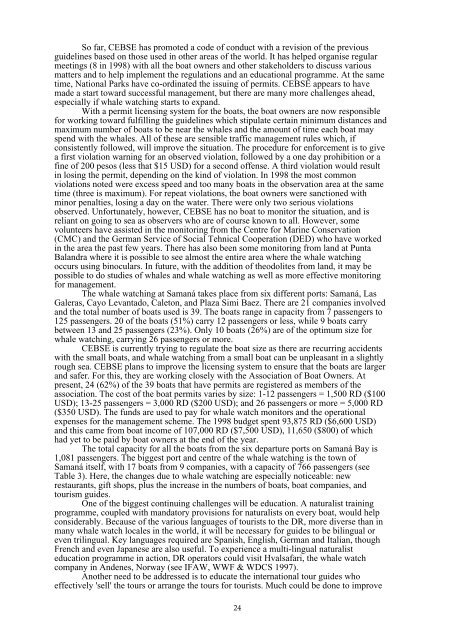The Potential of Whale Watching in the Caribbean: 1999+
The Potential of Whale Watching in the Caribbean: 1999+
The Potential of Whale Watching in the Caribbean: 1999+
You also want an ePaper? Increase the reach of your titles
YUMPU automatically turns print PDFs into web optimized ePapers that Google loves.
So far, CEBSE has promoted a code <strong>of</strong> conduct with a revision <strong>of</strong> <strong>the</strong> previous<br />
guidel<strong>in</strong>es based on those used <strong>in</strong> o<strong>the</strong>r areas <strong>of</strong> <strong>the</strong> world. It has helped organise regular<br />
meet<strong>in</strong>gs (8 <strong>in</strong> 1998) with all <strong>the</strong> boat owners and o<strong>the</strong>r stakeholders to discuss various<br />
matters and to help implement <strong>the</strong> regulations and an educational programme. At <strong>the</strong> same<br />
time, National Parks have co-ord<strong>in</strong>ated <strong>the</strong> issu<strong>in</strong>g <strong>of</strong> permits. CEBSE appears to have<br />
made a start toward successful management, but <strong>the</strong>re are many more challenges ahead,<br />
especially if whale watch<strong>in</strong>g starts to expand.<br />
With a permit licens<strong>in</strong>g system for <strong>the</strong> boats, <strong>the</strong> boat owners are now responsible<br />
for work<strong>in</strong>g toward fulfill<strong>in</strong>g <strong>the</strong> guidel<strong>in</strong>es which stipulate certa<strong>in</strong> m<strong>in</strong>imum distances and<br />
maximum number <strong>of</strong> boats to be near <strong>the</strong> whales and <strong>the</strong> amount <strong>of</strong> time each boat may<br />
spend with <strong>the</strong> whales. All <strong>of</strong> <strong>the</strong>se are sensible traffic management rules which, if<br />
consistently followed, will improve <strong>the</strong> situation. <strong>The</strong> procedure for enforcement is to give<br />
a first violation warn<strong>in</strong>g for an observed violation, followed by a one day prohibition or a<br />
f<strong>in</strong>e <strong>of</strong> 200 pesos (less that $15 USD) for a second <strong>of</strong>fense. A third violation would result<br />
<strong>in</strong> los<strong>in</strong>g <strong>the</strong> permit, depend<strong>in</strong>g on <strong>the</strong> k<strong>in</strong>d <strong>of</strong> violation. In 1998 <strong>the</strong> most common<br />
violations noted were excess speed and too many boats <strong>in</strong> <strong>the</strong> observation area at <strong>the</strong> same<br />
time (three is maximum). For repeat violations, <strong>the</strong> boat owners were sanctioned with<br />
m<strong>in</strong>or penalties, los<strong>in</strong>g a day on <strong>the</strong> water. <strong>The</strong>re were only two serious violations<br />
observed. Unfortunately, however, CEBSE has no boat to monitor <strong>the</strong> situation, and is<br />
reliant on go<strong>in</strong>g to sea as observers who are <strong>of</strong> course known to all. However, some<br />
volunteers have assisted <strong>in</strong> <strong>the</strong> monitor<strong>in</strong>g from <strong>the</strong> Centre for Mar<strong>in</strong>e Conservation<br />
(CMC) and <strong>the</strong> German Service <strong>of</strong> Social Tehnical Cooperation (DED) who have worked<br />
<strong>in</strong> <strong>the</strong> area <strong>the</strong> past few years. <strong>The</strong>re has also been some monitor<strong>in</strong>g from land at Punta<br />
Balandra where it is possible to see almost <strong>the</strong> entire area where <strong>the</strong> whale watch<strong>in</strong>g<br />
occurs us<strong>in</strong>g b<strong>in</strong>oculars. In future, with <strong>the</strong> addition <strong>of</strong> <strong>the</strong>odolites from land, it may be<br />
possible to do studies <strong>of</strong> whales and whale watch<strong>in</strong>g as well as more effective monitor<strong>in</strong>g<br />
for management.<br />
<strong>The</strong> whale watch<strong>in</strong>g at Samaná takes place from six different ports: Samaná, Las<br />
Galeras, Cayo Levantado, Caleton, and Plaza Simi Baez. <strong>The</strong>re are 21 companies <strong>in</strong>volved<br />
and <strong>the</strong> total number <strong>of</strong> boats used is 39. <strong>The</strong> boats range <strong>in</strong> capacity from 7 passengers to<br />
125 passengers. 20 <strong>of</strong> <strong>the</strong> boats (51%) carry 12 passengers or less, while 9 boats carry<br />
between 13 and 25 passengers (23%). Only 10 boats (26%) are <strong>of</strong> <strong>the</strong> optimum size for<br />
whale watch<strong>in</strong>g, carry<strong>in</strong>g 26 passengers or more.<br />
CEBSE is currently try<strong>in</strong>g to regulate <strong>the</strong> boat size as <strong>the</strong>re are recurr<strong>in</strong>g accidents<br />
with <strong>the</strong> small boats, and whale watch<strong>in</strong>g from a small boat can be unpleasant <strong>in</strong> a slightly<br />
rough sea. CEBSE plans to improve <strong>the</strong> licens<strong>in</strong>g system to ensure that <strong>the</strong> boats are larger<br />
and safer. For this, <strong>the</strong>y are work<strong>in</strong>g closely with <strong>the</strong> Association <strong>of</strong> Boat Owners. At<br />
present, 24 (62%) <strong>of</strong> <strong>the</strong> 39 boats that have permits are registered as members <strong>of</strong> <strong>the</strong><br />
association. <strong>The</strong> cost <strong>of</strong> <strong>the</strong> boat permits varies by size: 1-12 passengers = 1,500 RD ($100<br />
USD); 13-25 passengers = 3,000 RD ($200 USD); and 26 passengers or more = 5,000 RD<br />
($350 USD). <strong>The</strong> funds are used to pay for whale watch monitors and <strong>the</strong> operational<br />
expenses for <strong>the</strong> management scheme. <strong>The</strong> 1998 budget spent 93,875 RD ($6,600 USD)<br />
and this came from boat <strong>in</strong>come <strong>of</strong> 107,000 RD ($7,500 USD), 11,650 ($800) <strong>of</strong> which<br />
had yet to be paid by boat owners at <strong>the</strong> end <strong>of</strong> <strong>the</strong> year.<br />
<strong>The</strong> total capacity for all <strong>the</strong> boats from <strong>the</strong> six departure ports on Samaná Bay is<br />
1,081 passengers. <strong>The</strong> biggest port and centre <strong>of</strong> <strong>the</strong> whale watch<strong>in</strong>g is <strong>the</strong> town <strong>of</strong><br />
Samaná itself, with 17 boats from 9 companies, with a capacity <strong>of</strong> 766 passengers (see<br />
Table 3). Here, <strong>the</strong> changes due to whale watch<strong>in</strong>g are especially noticeable: new<br />
restaurants, gift shops, plus <strong>the</strong> <strong>in</strong>crease <strong>in</strong> <strong>the</strong> numbers <strong>of</strong> boats, boat companies, and<br />
tourism guides.<br />
One <strong>of</strong> <strong>the</strong> biggest cont<strong>in</strong>u<strong>in</strong>g challenges will be education. A naturalist tra<strong>in</strong><strong>in</strong>g<br />
programme, coupled with mandatory provisions for naturalists on every boat, would help<br />
considerably. Because <strong>of</strong> <strong>the</strong> various languages <strong>of</strong> tourists to <strong>the</strong> DR, more diverse than <strong>in</strong><br />
many whale watch locales <strong>in</strong> <strong>the</strong> world, it will be necessary for guides to be bil<strong>in</strong>gual or<br />
even tril<strong>in</strong>gual. Key languages required are Spanish, English, German and Italian, though<br />
French and even Japanese are also useful. To experience a multi-l<strong>in</strong>gual naturalist<br />
education programme <strong>in</strong> action, DR operators could visit Hvalsafari, <strong>the</strong> whale watch<br />
company <strong>in</strong> Andenes, Norway (see IFAW, WWF & WDCS 1997).<br />
Ano<strong>the</strong>r need to be addressed is to educate <strong>the</strong> <strong>in</strong>ternational tour guides who<br />
effectively 'sell' <strong>the</strong> tours or arrange <strong>the</strong> tours for tourists. Much could be done to improve<br />
24
















